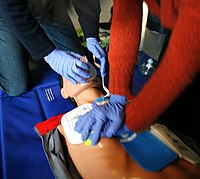
Recognition of out-of-hospital cardiac arrest during emergency calls and public awareness of cardiopulmonary resuscitation in communities: A multilevel analysis.
Sign Up to like & getrecommendations! Published in 2018 at "Resuscitation"
DOI: 10.1016/j.resuscitation.2018.05.008
Abstract: BACKGROUND For an effective dispatcher-assisted cardiopulmonary resuscitation (CPR) program, recognition of out-of-hospital cardiac arrest (OHCA) by a dispatcher is the first step in initiating bystander CPR. This study evaluated whether CPR awareness in the community… read more here.
Keywords: awareness; cpr instructions; cpr; recognition ... See more keywords

The effect of dispatcher-assisted cardiopulmonary resuscitation on early defibrillation and return of spontaneous circulation with survival.
Sign Up to like & getrecommendations! Published in 2019 at "Resuscitation"
DOI: 10.1016/j.resuscitation.2019.01.004
Abstract: BACKGROUND Dispatcher-assisted cardiopulmonary resuscitation (DA-CPR) programs are implemented to augment bystander CPR and improve outcomes of patients with out-of-hospital cardiac arrest (OHCA). To understand the pathway of how DA-CPR improves outcomes of OHCA, we aimed… read more here.
Keywords: cpr; defibrillation; bystander cpr; rosc ... See more keywords

Bystander cardiopulmonary resuscitation and cardiac rhythm change over time in patients with out-of-hospital cardiac arrest
Sign Up to like & getrecommendations! Published in 2023 at "Emergency Medicine Journal"
DOI: 10.1136/emermed-2022-212757
Abstract: Background Whether and how bystander cardiopulmonary resuscitation (CPR) modifies the cardiac rhythm after out-of-hospital cardiac arrest (OHCA) over time remains unclear. We investigated the association between bystander CPR and the likelihood of ventricular fibrillation (VF)… read more here.
Keywords: bystander cpr; cpr; cardiac rhythm; received bystander ... See more keywords

Protocol for a systematic review to identify the barriers and facilitators to deliver bystander cardiopulmonary resuscitation (CPR) in disadvantaged communities
Sign Up to like & getrecommendations! Published in 2018 at "Systematic Reviews"
DOI: 10.1186/s13643-018-0807-5
Abstract: BackgroundA key determinant of survival after out-of-hospital cardiac arrest (OHCA) is bystander cardio pulmonary resuscitation (CPR) which can more than double an individual’s chances of surviving to discharge from hospital. The experience of other international… read more here.
Keywords: deprived communities; systematic review; cpr; bystander cpr ... See more keywords

Factors Associated with Survival of Out-of-Hospital Cardiac Arrest by Cardiopulmonary Resuscitation of Bystander in Korea
Sign Up to like & getrecommendations! Published in 2021 at "Medico-Legal Update"
DOI: 10.37506/mlu.v21i4.3132
Abstract: Background: Out-of-hospital cardiac arrest (OHCA) affects more than 25,000 cases each year in Korea.The rate of survival and neurological recovery tend to increase in Korea, but less than other developedcountries. Despite the increase in bystander… read more here.
Keywords: korea; cpr; cardiac arrest; bystander cpr ... See more keywords

Globally, GDP Per Capita Correlates Strongly with Rates of Bystander CPR
Sign Up to like & getrecommendations! Published in 2022 at "Annals of Global Health"
DOI: 10.5334/aogh.3624
Abstract: Introduction: Bystander CPR is vital in improving outcomes for out-of-hospital cardiac arrest. There has been ample literature describing disparities in bystander CPR within specific countries, such as the United States, Australia, and the Netherlands. However,… read more here.
Keywords: bystander cpr; per capita; gdp per; rates bystander ... See more keywords